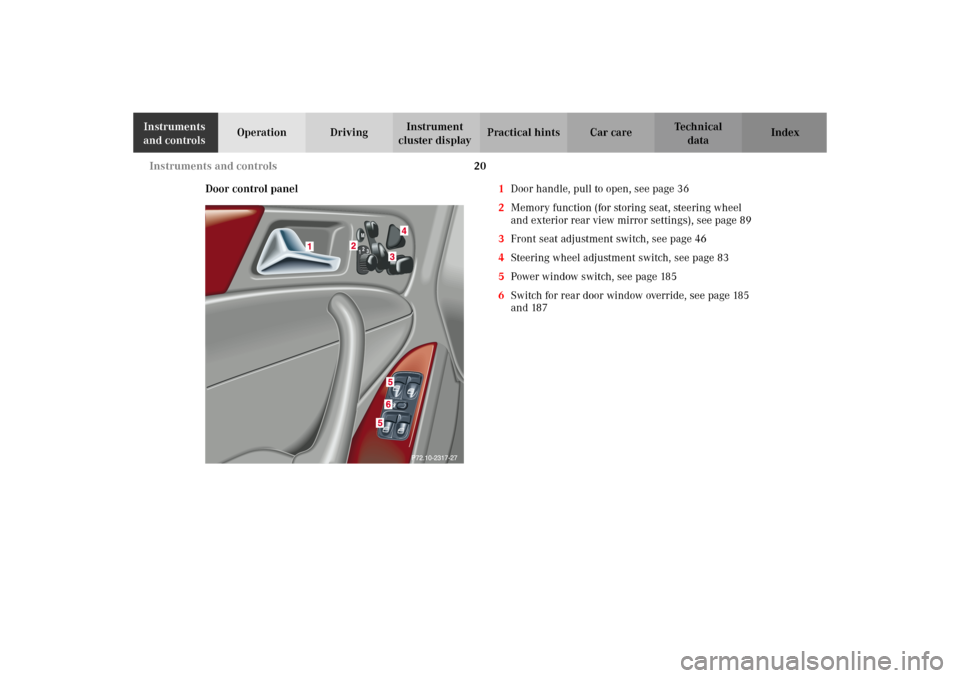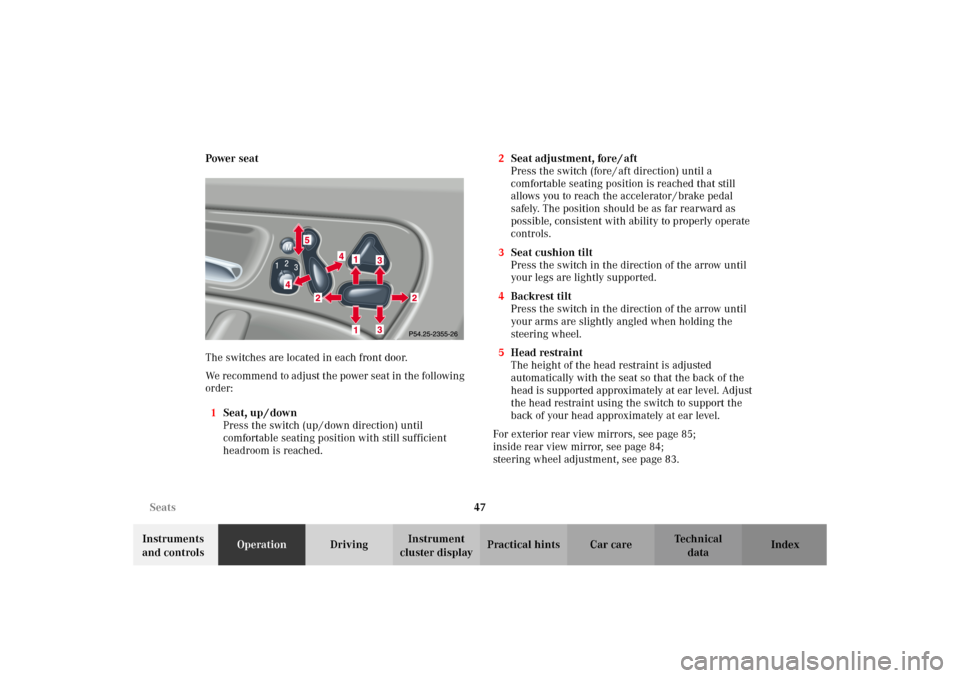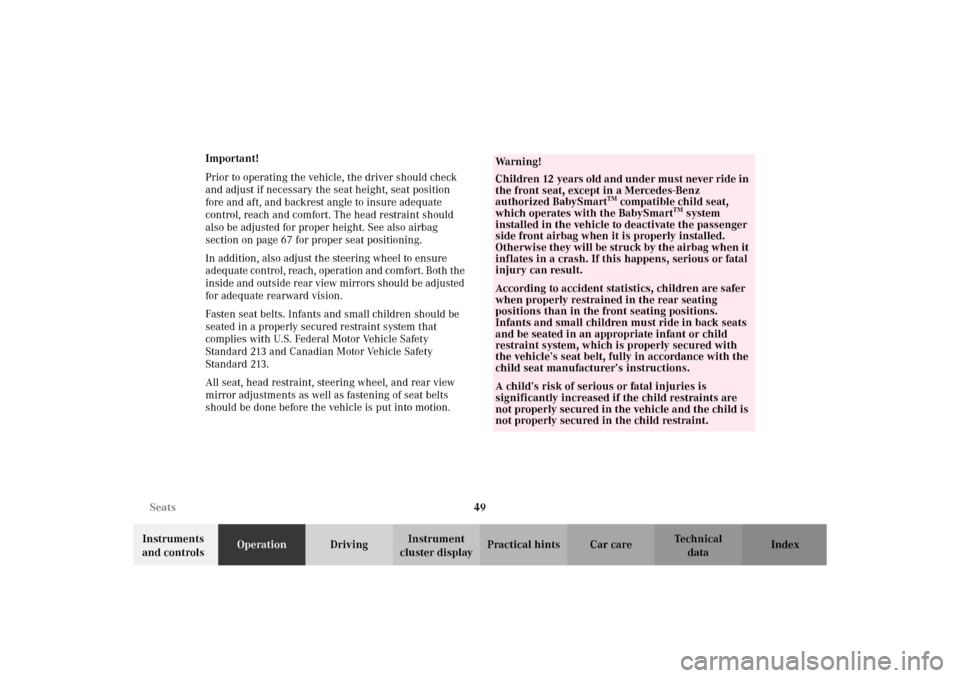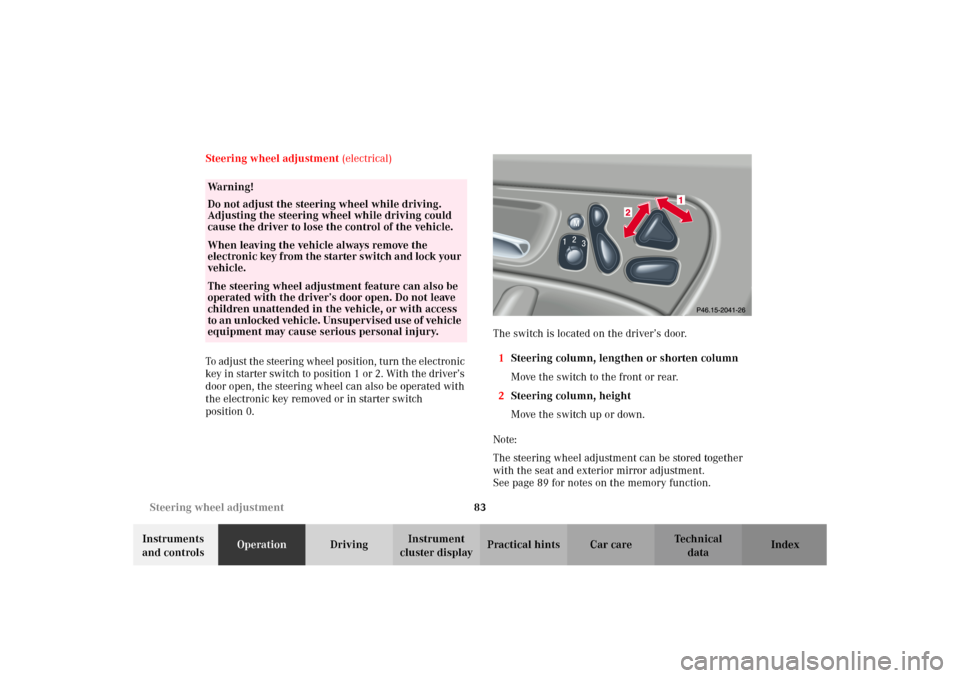2002 MERCEDES-BENZ C320 WAGON steering wheel adjustment
[x] Cancel search: steering wheel adjustmentPage 4 of 390

1 Contents
IntroductionProduct information .......................... 7
Operator’s manual ............................. 8
Where to find it ................................ 13
Reporting Safety Defects ................ 15Instruments and controlsInstruments and controls ............... 18
Door control panel ....................... 20
Overhead control panel ............... 21
Dashboard ..................................... 22
Center console .............................. 24OperationVehicle keys ...................................... 28
Start lock-out .................................... 30
General notes on the
central locking system ............... 30
Central locking system ................... 31
Radio frequency and
infrared remote control ............... 31
Locking and unlocking ................ 33Choosing global or selective
mode on remote control ............. 33
Opening and closing windows
and sliding / pop-up roof
from outside ................................. 34
Panic button ................................. 35
Mechanical keys .......................... 35
Doors ................................................. 36
Central locking switch .................... 38
Automatic central locking .............. 39
Emergency unlocking
in case of accident ...................... 39
Tailgate .............................................. 40
Opening the tailgate .................... 40
Emergency unlocking
the tailgate .....................................41
Closing the tailgate ..................... 42
Antitheft alarm system ................... 43
Tow-away alarm ............................... 44
Easy-entry/exit feature .................. 45
Front seat adjustment ..................... 46
Removal and installation of
front seat head restraints .......... 50
Multicontour seat .............................51Heated seats ..................................... 52
Rear seat head restraints ................ 53
Seat belts and integrated
restraint system .......................... 56
Seat belts ........................................... 56
Seat belt nonusage
warning system ........................... 57
BabySmart
TM airbag
deactivation system .................... 64
Supplemental Restraint
System (SRS) ............................... 65
Emergency tensioning
retractor (ETR) ............................. 66
Airbags .............................................. 67
Safety guidelines for the seat
belt, emergency tensioning
retractor and airbag .................... 75
Infant and child
restraint systems ......................... 77
Steering wheel adjustment
(electrical) .................................... 83
Rear view mirrors ............................ 84
Instrument cluster ........................... 92
Multifunction steering wheel,
multifunction display ................. 96
S203.book Seite 1 Freitag, 19. Oktober 2001 1:25 13
Page 23 of 390

20 Instruments and controls
Te ch n i c a l
data Instruments
and controlsOperation DrivingInstrument
cluster displayPractical hints Car care Index
Door control panel1Door handle, pull to open, see page 36
2Memory function (for storing seat, steering wheel
and exterior rear view mirror settings), see page 89
3Front seat adjustment switch, see page 46
4Steering wheel adjustment switch, see page 83
5Power window switch, see page 185
6Switch for rear door window override, see page 185
and 187
S203.book Seite 20 Freitag, 19. Oktober 2001 1:25 13
Page 26 of 390

23 Instruments and controls
Te ch n i c a l
data Instruments
and controlsOperation DrivingInstrument
cluster displayPractical hints Car care Index 1Hood lock release, see page 311
2Parking brake pedal, see page 252
3Parking brake release, see page 252
4Exterior lamp switch, see page 137
5Combination switch, see page 142
6Exterior mirror adjustment switch, see page 85
7Headlamp washer button, see page 141
8Cruise control switch, see page 2649Multifunction steering wheel, see page 96
Horn (with electronic key in starter switch
position 1 or 2)
10Instrument cluster, see page 92
11Voice recognition system switch, see separate
operating instructions
12Starter switch, see page 240
13Glove box lid release, see page 195
14Glove box lock, see page 195
S203.book Seite 23 Freitag, 19. Oktober 2001 1:25 13
Page 29 of 390

26 Contents - Operation
Te ch n i c a l
data Instruments
and controlsOperationDrivingInstrument
cluster displayPractical hints Car care Index
OperationVehicle keys ...................................... 28
Start lock-out .................................... 30
General notes on the
central locking system ............... 30
Central locking system ................... 31
Radio frequency and
infrared remote control ............... 31
Locking and unlocking ................ 33
Choosing global or selective
mode on remote control .............. 33
Opening and closing windows
and sliding / pop-up roof
from outside .................................. 34
Panic button .................................. 35
Mechanical keys ........................... 35
Doors .................................................. 36
Central locking switch .................... 38
Automatic central locking .............. 39
Emergency unlocking
in case of accident ...................... 39
Tailgate .............................................. 40
Opening the tailgate .................... 40Emergency unlocking
the tailgate .....................................41
Closing the tailgate ..................... 42
Antitheft alarm system ................... 43
Tow-away alarm ............................... 44
Easy-entry/exit feature .................. 45
Front seat adjustment ..................... 46
Removal and installation of
front seat head restraints .......... 50
Multicontour seat .............................51
Heated seats ..................................... 52
Rear seat head restraints ............... 53
Seat belts and integrated
restraint system .......................... 56
Seat belts .......................................... 56
Seat belt nonusage
warning system .......................... 57
BabySmart
TM airbag
deactivation system ................... 64
Supplemental Restraint
System (SRS) ............................... 65
Emergency tensioning
retractor (ETR) ............................ 66
Airbags .............................................. 67Safety guidelines for the seat
belt, emergency tensioning
retractor and airbag .................... 75
Infant and child
restraint systems ......................... 77
Steering wheel adjustment
(electrical) .................................... 83
Rear view mirrors ............................ 84
Instrument cluster ........................... 92
Multifunction steering wheel,
multifunction display ................. 96
Trip and main odometer
and sub menu ............................ 100
Audio systems ................................ 102
Radio ............................................ 102
CD player ..................................... 103
Cassette player ........................... 104
Telephone ........................................ 105
Navigation system ...........................110
Trip computer .................................. 111
Malfunction/warning
message memory .......................113
Individual settings ..........................115
Setting the audio volume ............. 130
S203.book Seite 26 Freitag, 19. Oktober 2001 1:25 13
Page 50 of 390

47 Seats
Te ch n i c a l
data Instruments
and controlsOperationDrivingInstrument
cluster displayPractical hints Car care Index Power seat
The switches are located in each front door.
We recommend to adjust the power seat in the following
order:
1Seat, up / down
Press the switch (up / down direction) until
comfortable seating position with still sufficient
headroom is reached.2Seat adjustment, fore / aft
Press the switch (fore / aft direction) until a
comfortable seating position is reached that still
allows you to reach the accelerator / brake pedal
safely. The position should be as far rearward as
possible, consistent with ability to properly operate
controls.
3Seat cushion tilt
Press the switch in the direction of the arrow until
your legs are lightly supported.
4Backrest tilt
Press the switch in the direction of the arrow until
your arms are slightly angled when holding the
steering wheel.
5Head restraint
The height of the head restraint is adjusted
automatically with the seat so that the back of the
head is supported approximately at ear level. Adjust
the head restraint using the switch to support the
back of your head approximately at ear level.
For exterior rear view mirrors, see page 85;
inside rear view mirror, see page 84;
steering wheel adjustment, see page 83.
S203.book Seite 47 Freitag, 19. Oktober 2001 1:25 13
Page 52 of 390

49 Seats
Te ch n i c a l
data Instruments
and controlsOperationDrivingInstrument
cluster displayPractical hints Car care Index Important!
Prior to operating the vehicle, the driver should check
and adjust if necessary the seat height, seat position
fore and aft, and backrest angle to insure adequate
control, reach and comfort. The head restraint should
also be adjusted for proper height. See also airbag
section on page 67 for proper seat positioning.
In addition, also adjust the steering wheel to ensure
ad eq uate con tr ol, r each, operation and com fort. B ot h the
inside and outside rear view mirrors should be adjusted
for adequate rearward vision.
Fasten seat belts. Infants and small children should be
seated in a properly secured restraint system that
complies with U.S. Federal Motor Vehicle Safety
Standard 213 and Canadian Motor Vehicle Safety
Standard 213.
All seat, head restraint, steering wheel, and rear view
mirror adjustments as well as fastening of seat belts
should be done before the vehicle is put into motion.
Wa r n i n g !
Children 12 years old and under must never ride in
the front seat, except in a Mercedes-Benz
authorized BabySmart
TM compatible child seat,
which operates with the BabySmart
TM system
installed in the vehicle to deactivate the passenger
side front airbag when it is properly installed.
Otherwise they will be struck by the airbag when it
inflates in a crash. If this happens, serious or fatal
injury can result.
According to accident statistics, children are safer
when properly restrained in the rear seating
positions than in the front seating positions.
Infants and small children must ride in back seats
and be seated in an appropriate infant or child
restraint system, which is properly secured with
the vehicle’s seat belt, fully in accordance with the
child seat manufacturer’s instructions.A child’s risk of serious or fatal injuries is
significantly increased if the child restraints are
not properly secured in the vehicle and the child is
not properly secured in the child restraint.
S203.book Seite 49 Freitag, 19. Oktober 2001 1:25 13
Page 75 of 390

72 Restraint systems
Te ch n i c a l
data Instruments
and controlsOperationDrivingInstrument
cluster displayPractical hints Car care Index
Your vehicle was originally equipped with airbags
which are designed to activate in certain impacts
exceeding a preset threshold to reduce the potential
and severity of injury. It is important to your safety
a nd tha t of your pas sen ger t hat you repl ac e d epl oyed
airbags and repair any malfunctioning airbags to
ensure the vehicle will continue to provide crash
protection for occupants.
Wa r n i n g !
To reduce the risk of injury when the front airbags
inflate, it is very important for the driver and front
passenger to always be in a properly seated
position and to wear your seat belt.For maximum protection in the event of a collision
always be in normal seated position with your back
against the backrest. Fasten your seat belt and
ensure that it is properly positioned on your body.Since the airbag inflates with considerable speed
and force, a proper seating and hands on steering
wheel position will help to keep you at a safe
distance from the airbag. Occupants who are
unbelted, out of position or too close to the airbag
can be seriously injured by an airbag as it inflates
with great force in the blink of an eye:
• Sit properly belted in an upright position with
your back against the backrest.• Adjust the driver seat as far as possible
rearward, still permitting proper operation of
vehicle controls. The distance from the center
of the driver’s breastbone to the center of the
airbag cover on the steering wheel must be at
least ten inches (25 cm) or more. You should be
able to accomplish this by a combination of
adjustments to the seat and steering wheel. If
you have any problems, please see your
authorized Mercedes-Benz Center.• Do not lean with your head or chest close to the
steering wheel or dashboard.• Keep hands on the outside of steering wheel
rim. Placing hands and arms inside the rim
can increase the risk and potential severity of
hand / arm injury when driver front airbag
inflates.• Adjust the front passenger seat as far as
possible rearward from the dashboard when
the seat is occupied.
S203.book Seite 72 Freitag, 19. Oktober 2001 1:25 13
Page 86 of 390

83 Steering wheel adjustment
Te ch n i c a l
data Instruments
and controlsOperationDrivingInstrument
cluster displayPractical hints Car care Index Steering wheel adjustment (electrical)
To ad j ust the ste ering wheel pos ition , turn t he electron ic
key in starter switch to position 1 or 2. With the driver’s
door open, the steering wheel can also be operated with
the electronic key removed or in starter switch
position 0.The switch is located on the driver’s door.
1Steering column, lengthen or shorten column
Move the switch to the front or rear.
2Steering column, height
Move the switch up or down.
Note:
The steering wheel adjustment can be stored together
with the seat and exterior mirror adjustment.
See page 89 for notes on the memory function.
Wa r n i n g !
Do not adjust the steering wheel while driving.
Adjusting the steering wheel while driving could
cause the driver to lose the control of the vehicle.When leaving the vehicle always remove the
electroni c key f rom t he sta rter s wi tch a nd lock your
vehicle.The steering wheel adjustment feature can also be
operated with the driver’s door open. Do not leave
children unattended in the vehicle, or with access
to a n un locked vehi cle. Un supervi sed use of vehicl e
equipment may cause serious personal injury.
S203.book Seite 83 Freitag, 19. Oktober 2001 1:25 13